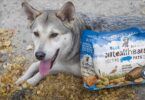Over 38% of pet owners admit to sharing human food with their furry companions. But when it comes to luxury seafood like lobster, questions about safety and nutrition arise. This article examines whether this shellfish fits into a balanced diet for pets and how to serve it responsibly.
Lobster offers protein and essential minerals, but improper preparation poses risks. Shells, butter, or seasoning can harm a dog’s digestive system. Veterinary professionals stress that moderation and plain cooking methods are non-negotiable for pet safety.
This guide explores both advantages and pitfalls of feeding crustaceans to four-legged friends. You’ll learn how to identify allergies, calculate portion sizes, and recognize signs of adverse reactions. Insights from Purina, AZ Animals, and Barking Royalty provide science-backed clarity.
Discover alternative seafood options that deliver similar nutrients without the hazards. Whether you’re considering a special treat or exploring new protein sources, this resource equips you with practical advice tailored to your pup’s needs.
Trustworthy pet care starts with informed decisions. Let’s dive into the facts to ensure every meal supports your companion’s health.
Introduction to Lobster as a Canine Treat
Lobster, a prized delicacy in human cuisine, sparks curiosity among pet owners exploring gourmet options for their companions. While its rich flavor appeals to pets, introducing this shellfish requires careful consideration of nutritional value and safety protocols.
This seafood contains omega-3 fatty acids, which support skin health and joint function. These nutrients, along with lean protein, make it a tempting addition to a dog’s diet when prepared plainly. However, its hard shell poses a choking hazard and must be fully removed before serving.
Moderation is key. Veterinarians recommend treating lobster as an occasional snack rather than a staple. Pairing small portions with regular meals ensures variety without disrupting balanced nutrition. Always avoid butter, oils, or seasonings that could upset a pet’s stomach.
Understanding these guidelines helps owners make informed choices about unconventional foods. Thoughtful preparation and portion control allow pets to enjoy novel flavors safely.
Can Dogs Eat Lobster: Breaking Down the Facts
Many pet parents wonder if their furry friend’s menu can include luxurious seafood. The answer is yes—when prepared correctly. Cooked lobster meat (without shells or seasoning) offers a safe protein source packed with essential nutrients like zinc and vitamin B12. Always avoid raw shellfish, as it may harbor harmful parasites or bacteria.
Plain, steamed lobster provides lean protein that supports muscle maintenance. However, its cholesterol and sodium content means portions should stay small—think bite-sized treats, not meals. Introduce it slowly to monitor for allergic reactions like itching or digestive upset.
Consulting a veterinarian before offering new foods ensures compatibility with your pet’s health needs. Trusted sources like Purina confirm that occasional plain lobster aligns with balanced diets when paired with regular kibble. For safer shellfish alternatives, consider crab meat, which shares similar nutritional benefits without the same preparation risks.
Misconceptions about lobster often center on its shells or seasoning. Remember: only serve fully cleaned, unseasoned meat. This approach minimizes hazards while letting pets enjoy novel flavors responsibly.
Nutritional Benefits of Lobster for Your Dog
Exploring nutrient-rich foods helps pet owners enhance their companion’s meals responsibly. When prepared correctly, this shellfish offers valuable compounds that complement standard diets without excess calories.
Muscle Support Through Premium Protein
High-protein content makes lobster meat ideal for maintaining lean muscle mass. Each serving delivers amino acids essential for energy production and tissue repair. Compared to chicken or salmon, it provides similar protein density with fewer saturated fats.
Essential Fatty Acids for Vital Functions
Omega-3 fatty acids in this seafood promote skin hydration and reduce inflammation. These compounds also support cognitive health and joint mobility, particularly in older pets. Regular intake of fatty acids contributes to a glossy coat and improved immune responses.
Zinc and selenium in lobster aid metabolic processes and thyroid function. Vitamin B12 supports nerve health while phosphorus strengthens bones. Such nutrients make it a great source of micronutrients when served occasionally.
While nutritious, lobster should never replace balanced meals. Pair bite-sized portions with regular kibble to avoid dietary imbalances. Always consult a vet to confirm compatibility with your pet’s specific health needs.
Potential Risks and Hazards of Lobster Consumption
While shellfish can offer nutritional perks, improper handling or serving creates preventable dangers. Understanding these risks ensures pets enjoy novel treats without compromising their well-being.
Choking Hazards and Shell-Related Dangers
Shell fragments pose immediate physical threats. Sharp edges can tear the throat, stomach, or intestines. Even small pieces may block airways, requiring emergency care.
Always remove every trace of shell before serving. Double-check meat for hidden cartilage or debris. Supervise pets during feeding to catch unexpected reactions quickly.
Issues with Sodium, Cholesterol, and Fat Content
Lobster naturally contains high sodium and cholesterol levels. Overconsumption strains the kidneys and may trigger pancreatitis. Excess fat disrupts digestion, causing vomiting or diarrhea.
Raw shellfish heightens risks further. Harmful bacteria or parasites thrive in uncooked meat, leading to food poisoning. Cooking eliminates most pathogens but avoid adding salt or oils.
Moderation remains critical. Offer tiny portions occasionally—never exceeding 10% of daily calories. Watch for signs like lethargy or loss of appetite, and contact a vet immediately if symptoms arise.
Proper Preparation and Serving Methods
Introducing new foods to pets requires precision to balance safety and nutrition. Proper techniques ensure shellfish becomes a rewarding addition rather than a hazard. Follow these guidelines to minimize risks while maximizing benefits.
Safe Cooking Techniques and Ingredient Precautions
Steaming or boiling lobster without seasoning is the only safe method. Salt, garlic, and butter can harm a pet’s digestive system. Remove all shell fragments and cartilage thoroughly—even small pieces pose choking risks.
Never serve raw or undercooked meat. High heat eliminates harmful bacteria while preserving nutrients. Let the meat cool completely before cutting it into pea-sized bites. For more on safe seafood practices, explore our guide on shrimp safety.
Portion Control and Frequency Recommendations
Limit portions to one teaspoon per 10 pounds of body weight. This ensures treats don’t exceed 10% of daily calories. Offer lobster no more than twice monthly to prevent sodium buildup.
Consult your vet to confirm suitable amounts for your companion’s size and health status. Pair small servings with regular meals to maintain a balanced dog diet. Track reactions like itching or stomach upset, and discontinue use if issues arise.
Allergy Concerns and the Importance of Veterinary Guidance
Food sensitivities in pets often surprise owners, even with carefully chosen treats. While shellfish offers nutritional value, individual reactions vary widely. Proactive monitoring and professional input remain essential for maintaining dog health.
Recognizing Allergic Reactions
Common signs include excessive scratching, facial swelling, or sudden digestive issues. Hives around the ears and persistent licking often indicate discomfort. Severe cases may involve labored breathing—a situation requiring urgent vet care.
Introduce new proteins like shellfish in pea-sized portions. Wait 24-48 hours before offering more. Track behavior changes through a journal or mobile app for accurate reporting.
Immediately contact your veterinarian if symptoms emerge. They might recommend antihistamines or elimination diets to pinpoint triggers. Never attempt home remedies without professional approval—missteps could worsen reactions.
Regular check-ups help identify underlying conditions affecting food tolerance. Share your pet’s treat history during visits to inform personalized dietary advice. With vet oversight, many companions enjoy novel flavors safely.
Responsible treat practices balance curiosity with caution. Partnering with animal health experts ensures every snack supports long-term wellness.
Exploring Alternative Seafood and Treat Options
Pet owners seeking diverse protein sources often explore seafood beyond traditional meats. While some options carry risks, others provide comparable nutrients with simpler preparation. Thoughtful selection ensures pets enjoy variety without compromising their health.
Other Safe Shellfish and Seafood Choices
Cooked shrimp and salmon rank among the safest shellfish alternatives. These options deliver lean protein and omega-3 fatty acids while being easier to prepare. Crab meat offers similar benefits but requires thorough shell removal to prevent choking hazards.
White fish like cod or haddock provide low-fat protein sources. Canned tuna in water (never oil) serves as an occasional treat. Always avoid bones, skins, and seasoning when serving these fish varieties.
Healthy Alternatives for a Balanced Diet
Commercial treats infused with seafood flavors offer convenience without preparation stress. Look for vet-approved products containing limited ingredients and no artificial additives. Rotating between different proteins prevents nutrient imbalances and maintains mealtime interest.
Steamed mussels or clams supply zinc and vitamin B12 in moderation. Remove all shells completely and serve plain. Pair these treats with fiber-rich vegetables like green beans for digestive support.
Raw seafood remains off-limits due to bacterial risks. Stick to fully cooked options and limit portions to 10% of daily calories. Consulting a veterinarian helps tailor choices to your pet’s specific dietary needs while ensuring long-term wellness.
Final Thoughts on Feeding Lobster to Your Dog
Balancing gourmet treats with nutritional safety requires careful planning for pet owners. Plain, cooked lobster meat offers protein and essential minerals when served sparingly. However, risks like choking hazards from shells or digestive upset from seasoning demand strict preparation guidelines.
Portion control remains critical—stick to veterinarian-recommended quantities based on your companion’s size. Never share seasoned dishes meant for humans, as spices and butter harm pets. For alternative nutrient sources, consider salmon skin, which provides omega-3s with fewer preparation challenges.
Always consult your vet before introducing new proteins, especially if your pet has allergies or health conditions. Monitor reactions closely after initial servings, adjusting their diet as needed. While people enjoy sharing special foods, a dog’s nutritional needs differ significantly from ours.
Ultimately, informed choices paired with professional guidance let pets enjoy varied flavors safely. Prioritize their well-being by treating lobster as an occasional indulgence within a balanced dog diet.
FAQ
Is lobster safe for pets to consume occasionally?
Plain, cooked lobster meat—free of shells, butter, or seasoning—can be offered in tiny amounts as an occasional treat. Always consult a veterinarian first, especially for pets with dietary restrictions or health conditions like pancreatitis.
What nutrients make lobster a potential addition to a pet’s diet?
Lobster provides high-quality protein for muscle health and omega-3 fatty acids, which support skin, coat, and joint function. It also contains vitamins B12 and E, zinc, and magnesium, though these nutrients should come primarily from balanced commercial pet foods.
How do shells pose risks during feeding?
Sharp, hard shells can splinter and cause intestinal blockages or mouth injuries. Even small fragments may lead to choking or digestive issues. Always remove all shell parts before offering any seafood to pets.










Leave a Comment